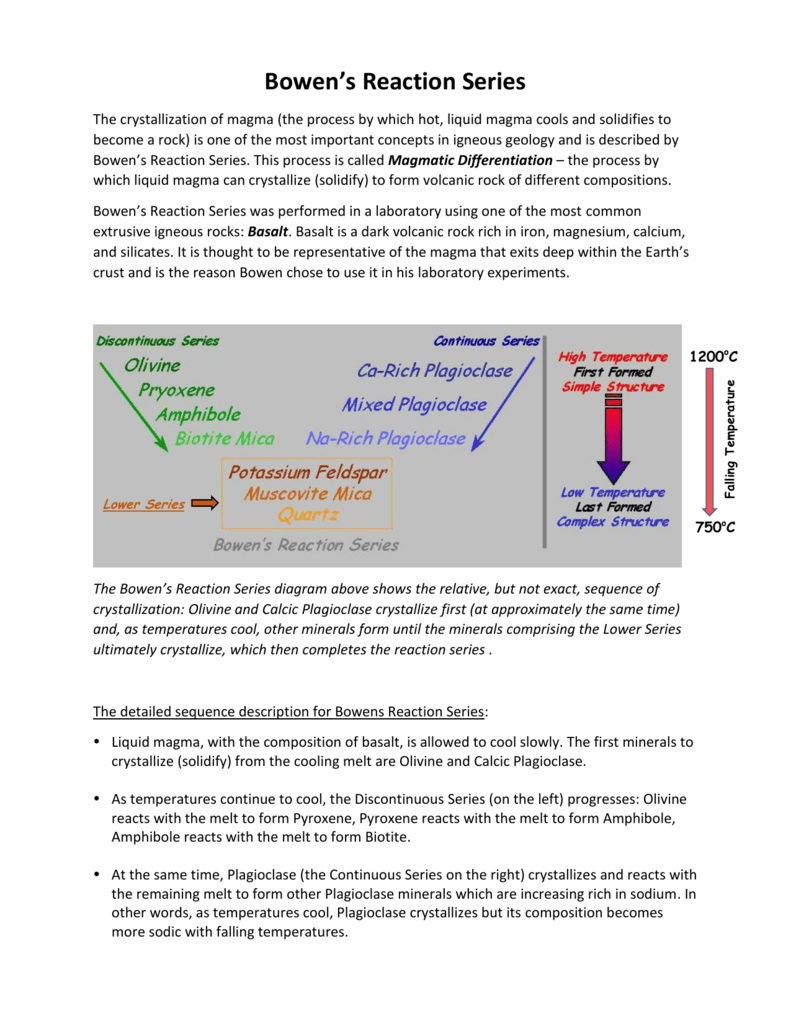44 bowen's reaction series diagram
Figure 5: Bowen's reaction series showing the sequence of minerals that would be formed and removed during fractional crystallization of a melt. Aug 17, 2021 · Figure 5.2. 1: Olivine, the first mineral to crystallize in a melt. Bowen’s Reaction Series describes the temperature at which minerals crystallize when cooled, or melt when heated. The low end of the temperature scale where all minerals crystallize into solid rock is approximately 700°C (158°F).
The remarkable thing that Bowen found concerned the discontinuous branch. At a certain temperature a magma might produce olivine, but if that same magma was ...

Bowen's reaction series diagram
reaction series and the continuous reaction series. Look at the diagram of Bowen's Reaction Series on the next page. The Discontinuous Reaction Series The left-hand side of Bowen's Reaction series. These are a group of mafic or iron-magnesium bearing minerals - olivine, pyroxene, amphibole, and biotite. If the chemistry of Bowen’s Reaction Series. Bowen’s reaction series is based on observations and experiments of natural rocks, the crystallization sequence of typical basaltic magma change as they cool. It is a sorting tool according to the temperature at which they crystallize common magmatic silicate minerals. Bowen’s Reaction Series describes temperatures at which different common silicate minerals change from liquid to solid phase (or solid to liquid). Bowen determined that specific minerals form at specific temperatures as a magma cools. At the higher temperatures associated with mafic and intermediate magmas ...
Bowen's reaction series diagram. Start studying Bowen's Reaction Series. Learn vocabulary, terms, and more with flashcards, games, and other study tools. Bowen's reaction series is a means of ranking common igneous silicate minerals ... Minerals on the left part of the "Y" of the diagram are what are called.2 pages Sep 21, 2021 · Bowen's reaction series can be defined as the crystallization sequence of magma as cooling occurs. It has two parts, the discontinuous series and the continuous series. It has two parts, the ... Examples of the use of Bowen's Reaction Series are (figure 1): 1) From the top diagram you can interpret the physical and chemical conditions under which a mineral crystallized. For example, olivine is a high temperature and pressure mineral with high iron and magnesium, and low silica.
Since the surface of the Earth is a low temperature environment compared to the zones of rock formation, the chart also reflects the relative stability of ... 5 Aug 2020 — Bowen's Reaction Series describes the temperature at which minerals crystallize when cooled, or melt when heated. The low end of the temperature ... Bowen determined that specific minerals form at specific temperatures as a magma cools. At the higher temperatures associated with mafic and intermediate magmas ... Bowen’s Reaction Series. Bowen’s reaction series is based on observations and experiments of natural rocks, the crystallization sequence of typical basaltic magma change as they cool. It is a sorting tool according to the temperature at which they crystallize common magmatic silicate minerals. Bowen’s Reaction Series describes temperatures at which different common silicate minerals change from liquid to solid phase (or solid to liquid).
reaction series and the continuous reaction series. Look at the diagram of Bowen's Reaction Series on the next page. The Discontinuous Reaction Series The left-hand side of Bowen's Reaction series. These are a group of mafic or iron-magnesium bearing minerals - olivine, pyroxene, amphibole, and biotite. If the chemistry of




0 Response to "44 bowen's reaction series diagram"
Post a Comment